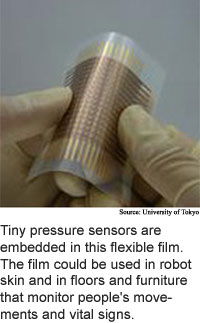Takao Someya and his team from the University of Tokyo have devised pressure-sensor arrays (with a density of 16 sensors per square centimeter) that promise to give objects like rugs and robots the equivalent of pressure sensitivity.

The “skin” is made of electricity-conducting rubber and organic transistors and could be used to monitor the heart and breathing rate of a hospital patient distinguishing whether he is just taking a rest, or has fallen to the floor. They could also be integrated in pressure carpets that distinguish family members from strangers or in car seats to monitor drivers’ mental and physical conditions.
The skin could eventually be used to make domestic robots more appropriately sensitive of their surroundings, enabling them to gently lift a person.
Electronic skin could be ready for practical use in four to five years.
![20047917633_8[1].jpg](http://www.we-make-money-not-art.com/xxx/20047917633_8%5B1%5D.jpg)
From TRN, via FutureWire.
Also in Red Herring.







